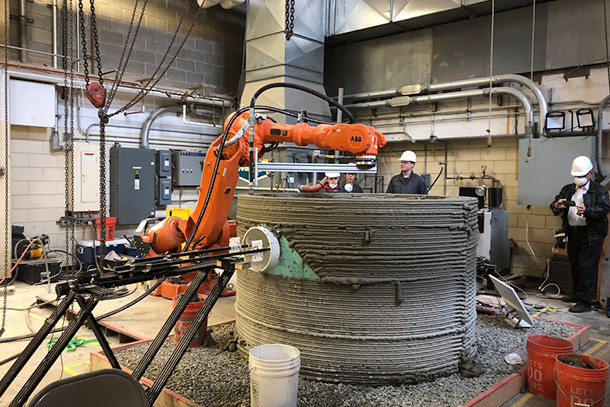The College of Engineering’s Engineering for Innovation & Entrepreneurship (ENGINE) and the College of Arts and Architecture respectively grant $50,000 & $25,000 to Penn State University researchers to advance concrete 3D Printing.
Currently, conventional concrete consists of ordinary Portland cement (OPC), water, sand and aggregates. The production of each ton of OPC, the primary ingredient in concrete, requires between 1,700 and 1,800 megajoules of energy — enough to power about 500 100-watt lightbulbs for 10 hours. Production of each ton of OPC also emits about one ton of carbon dioxide into the Earth’s atmosphere. These numbers mean the cement industry generates about 5% of the total carbon dioxide emissions created by humans.
Expanding on its cement-free MarsCrete product, the researchers are designing high-performance, sustainable concrete through the development of a new cement-based mixture, primarily for home building and small building construction.
The 3D-printer system integrates a dual mixer and pump that feeds a nozzle manipulated by an industrial six-axis robotic arm. The team used the same 3D Printer two years ago to compete during the NASA challenge.
“The concrete formulations and the printer system are tightly coupled, as the design of one affects the design of the other,” Sven Bilén, head of the School of Engineering Design, Technology, and Professional Programs said. “We have to work from the micro-scale to the macro-scale. Our work is also tightly coupled to the architectural designs that can be realized via our materials and printing methods. All three — materials, printing system and architecture — must be considered together.”
The aim is not to replace conventional construction
Current benefits of concrete 3D Printing include minimized construction waste, faster construction, less labor, more economical construction and building in limited-resource areas or areas that are hazardous for humans.
“The technology for 3D printing of concrete is not being developed to replace conventional construction that can be carried out economically with existing methods,” principal investigator (PI) Ali Memari explains. “Rather, this technology will be more useful for complex designs, where conventional methods of using formwork will be much more expensive or prohibitive.”
Through three parallel, interdisciplinary streams of research — material mixture, material characterization and design, and printing process and system — and its interdisciplinary nature, the team can better understand the effects of each variable on the printing process. According to the researchers, this will allow better control of the printing system, ultimately creating successful structures.
You can now post free of charge job opportunities in the AM Industry on 3D ADEPT Media.
For further information about 3D Printing, follow us on our social networks and subscribe to our newsletter : Facebook, Twitter, LinkedIn & Instagram !Would you like to be featured in the next issue of our digital magazine? Send us an email at contact@3dadept.com






